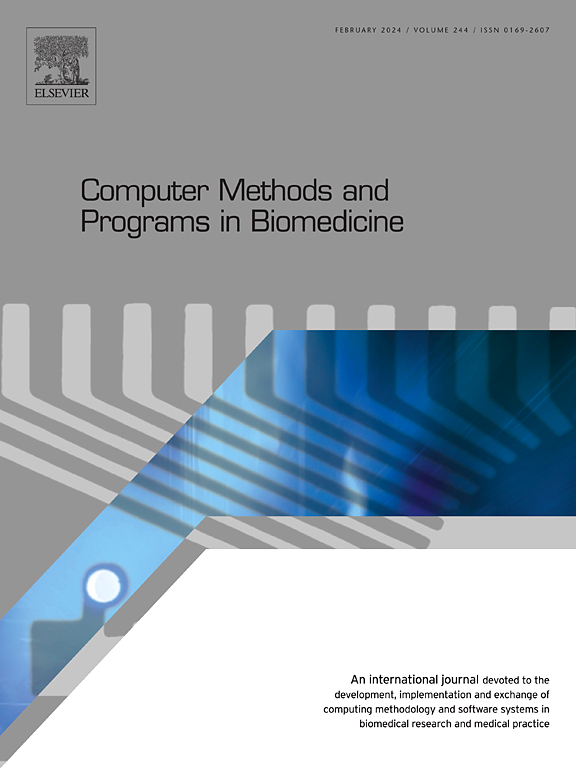Self-supervised multi-modality learning for multi-label skin lesion classification
IF 4.9
2区 医学
Q1 COMPUTER SCIENCE, INTERDISCIPLINARY APPLICATIONS
引用次数: 0
Abstract
Background:
The clinical diagnosis of skin lesions involves the analysis of dermoscopic and clinical modalities. Dermoscopic images provide detailed views of surface structures, while clinical images offer complementary macroscopic information. Clinicians frequently use the seven-point checklist as an auxiliary tool for melanoma diagnosis and identifying lesion attributes. Supervised deep learning approaches, such as convolutional neural networks, have performed well using dermoscopic and clinical modalities (multi-modality) and further enhanced classification by predicting seven skin lesion attributes (multi-label). However, the performance of these approaches is reliant on the availability of large-scale labeled data, which are costly and time-consuming to obtain, more so with annotating multi-attributes
Methods:
To reduce the dependency on large labeled datasets, we propose a self-supervised learning (SSL) algorithm for multi-modality multi-label skin lesion classification. Compared with single-modality SSL, our algorithm enables multi-modality SSL by maximizing the similarities between paired dermoscopic and clinical images from different views. We introduce a novel multi-modal and multi-label SSL strategy that generates surrogate pseudo-multi-labels for seven skin lesion attributes through clustering analysis. A label-relation-aware module is proposed to refine each pseudo-label embedding, capturing the interrelationships between pseudo-multi-labels. We further illustrate the interrelationships of skin lesion attributes and their relationships with clinical diagnoses using an attention visualization technique.
Results:
The proposed algorithm was validated using the well-benchmarked seven-point skin lesion dataset. Our results demonstrate that our method outperforms the state-of-the-art SSL counterparts. Improvements in the area under receiver operating characteristic curve, precision, sensitivity, and specificity were observed across various lesion attributes and melanoma diagnoses.
Conclusions:
Our self-supervised learning algorithm offers a robust and efficient solution for multi-modality multi-label skin lesion classification, reducing the reliance on large-scale labeled data. By effectively capturing and leveraging the complementary information between the dermoscopic and clinical images and interrelationships between lesion attributes, our approach holds the potential for improving clinical diagnosis accuracy in dermatology.
多标签皮肤病变分类的自监督多模态学习
背景:皮肤病变的临床诊断包括皮肤镜和临床表现的分析。皮肤镜图像提供了表面结构的详细视图,而临床图像提供了补充的宏观信息。临床医生经常使用七点检查表作为黑色素瘤诊断和识别病变属性的辅助工具。有监督的深度学习方法,如卷积神经网络,在皮肤镜和临床模式(多模式)和通过预测七种皮肤病变属性(多标签)进一步增强分类方面表现良好。然而,这些方法的性能依赖于大规模标记数据的可用性,而这些数据的获取成本高且耗时长,对多属性进行标注更是如此。方法:为了减少对大型标记数据集的依赖,我们提出了一种用于多模态多标签皮肤病变分类的自监督学习(SSL)算法。与单模态SSL相比,我们的算法通过最大化来自不同视角的配对皮肤镜和临床图像之间的相似性来实现多模态SSL。本文提出了一种新的多模态多标签SSL策略,通过聚类分析为7个皮肤病变属性生成代理伪多标签。提出了一个标签关系感知模块来细化每个伪标签嵌入,捕捉伪多标签之间的相互关系。我们进一步说明了相互关系的皮肤病变属性和他们的关系与临床诊断使用注意可视化技术。结果:该算法使用基准良好的七点皮肤病变数据集进行了验证。我们的结果表明,我们的方法优于最先进的SSL对应物。在各种病变属性和黑色素瘤诊断中观察到接受者工作特征曲线下的面积、精度、灵敏度和特异性的改善。结论:我们的自监督学习算法为多模态多标签皮肤病变分类提供了鲁棒高效的解决方案,减少了对大规模标记数据的依赖。通过有效地捕获和利用皮肤镜和临床图像之间的互补信息以及病变属性之间的相互关系,我们的方法具有提高皮肤科临床诊断准确性的潜力。
本文章由计算机程序翻译,如有差异,请以英文原文为准。
求助全文
约1分钟内获得全文
求助全文
来源期刊

Computer methods and programs in biomedicine
工程技术-工程:生物医学
CiteScore
12.30
自引率
6.60%
发文量
601
审稿时长
135 days
期刊介绍:
To encourage the development of formal computing methods, and their application in biomedical research and medical practice, by illustration of fundamental principles in biomedical informatics research; to stimulate basic research into application software design; to report the state of research of biomedical information processing projects; to report new computer methodologies applied in biomedical areas; the eventual distribution of demonstrable software to avoid duplication of effort; to provide a forum for discussion and improvement of existing software; to optimize contact between national organizations and regional user groups by promoting an international exchange of information on formal methods, standards and software in biomedicine.
Computer Methods and Programs in Biomedicine covers computing methodology and software systems derived from computing science for implementation in all aspects of biomedical research and medical practice. It is designed to serve: biochemists; biologists; geneticists; immunologists; neuroscientists; pharmacologists; toxicologists; clinicians; epidemiologists; psychiatrists; psychologists; cardiologists; chemists; (radio)physicists; computer scientists; programmers and systems analysts; biomedical, clinical, electrical and other engineers; teachers of medical informatics and users of educational software.
 求助内容:
求助内容: 应助结果提醒方式:
应助结果提醒方式:


